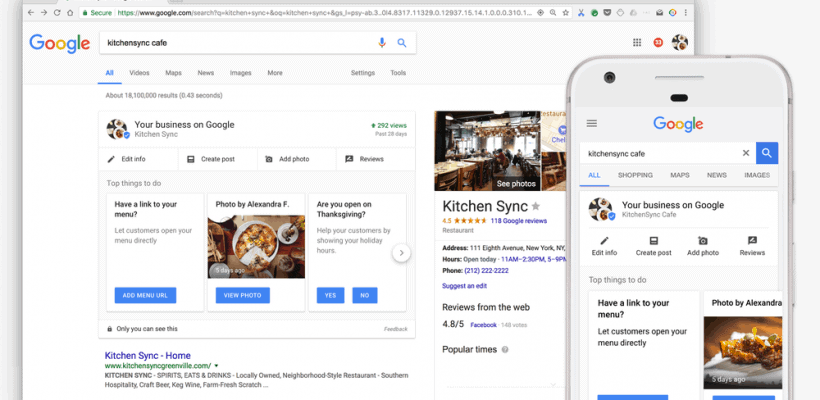
Coronavirus and Business: How To Market on a Budget and Stay Afloat During the Pandemic

Over the past few weeks, it has become clear that COVID-19’s impact will be far greater and far more devastating than any American could have anticipated. While everyone has been affected in one way or another, many families have peace of mind that the world will return to normal, and that, before it does, the government will step in to help them.
But what about small businesses? Unfortunately, for those companies affected by the economy while dealing with the coronavirus and business, peace of mind remains elusive.
Can Aggressive Coronavirus Marketing Help You Weather the Storm Caused by COVID-19?
In a matter of days, millions of Americans were asked to do the unthinkable: Stay home. Don’t go to work. Don’t go to school. Don’t go out for any reason other than for basic necessities and medical attention.
Some of the nation’s largest economies have been shut down completely, including Los Angeles, New York, San Francisco, San Diego, Chicago and Seattle. As of the end of March, 163 million people throughout 17 states, 14 counties and eight cities were asked to stay home.
Million People Have Been Asked To Stay Home
As a business owner, it’s easy to go into panic mode over those numbers, especially if you live in one of the hardest-hit cities. However, while you may be tempted to focus only on staying afloat during these tough times, now is the time to look ahead.
By taking a progressive approach instead of a preventative approach, you’ll fare better when times get better – and they will get better. Using the resources you do have to create a recession marketing strategy is one of the best ways to ensure business recession survival.
Businesses That Refocused Spending During Recessions Outperformed Others
While you may be tempted to make sweeping cuts and to halt all marketing efforts during the coronavirus pandemic, history says you shouldn’t.
According to a Harvard Business Review study that analyzed the performance of 4,700 public companies both three years before and after a recession, firms that cut costs at a hacksaw rate didn’t necessarily flourish. In fact, businesses that opted for a prevention focus had the lowest rates of profitability post-recession than businesses that chose a more aggressive, forward-thinking approach and continued advertising during a recession.
🚨A Harvard Business Review found that companies that cut costs during a recession had the lowest rates of profitability post-recession.🚨 #Coronavirus #COVID19 Share on XFindings from a Bain report back the findings from the Harvard study, and actually take the concept one step further. According to the report, successful leaders know that more discipline during boom times can provide for greater flexibility during lean ones, and that companies that get it “just right” during the lean years have a better chance of pulling ahead of the competition when things improve.
Unfortunately, not many businesses – large or small – anticipated something as economically catastrophic as COVID-19 when going about their day-to-day dealings. If your company didn’t set aside an emergency fund for the coronavirus and business, you may be operating on a very limited budget.
The good news is that thanks to the internet, marketing in a recession doesn’t have to be expensive. Read on for effective and cost-efficient coronavirus marketing tips.
Marketing Strategy Tips During a Recession
Your marketing strategy during a recession should include some of the same principles you’d employ when marketing on a tight budget – namely, that you want to get the best bang for your buck. This means you need to think outside the box and implement economic marketing strategies that are cost-effective to execute and extremely targeted. Here are some of our best tips for business recession survival:
1. Reach Out to Your Customers
COVID-19 has impacted everyone’s lives, whether they tested positive or not. We’ve all been asked to stay home. We’ve all been told not to eat at our favorite restaurants, shop at our favorite stores or socialize with others. We’ve all worried about where our next roll of toilet paper will come from.
Though these are all minor inconveniences (and jokes aside), they’re jarring nonetheless. Use this time not to push sales or bemoan your bad luck but rather to set your business apart from the others.

Call your customers and check in on them. Use social media to keep them updated on your business and your employees, and to spread good cheer in general.
Blog about how your customers can use your products or services to make sheltering in place less difficult, or how you plan to do so through your own efforts.
Many brands have expanded on this last idea and are reaching out in a big way:
- Bank of America is calling all 66 million of its customers to check in on them and make sure they have the resources necessary to get through the coronavirus outbreak.
- U-Haul is offering displaced college students 30 days of free storage.
- MGM Resorts International has donated 480,000 pounds of food to food banks and communities across the United States.
- Several grocers throughout the nation have dedicated certain hours to senior shopping and/or essential personnel only.
- Major cosmetic brands have shifted gears and are now focused on making hand sanitizer amidst the shortage.
- Burger King is giving away two free kids meals for every purchase made via its app.
- Uber Eats is donating 300,000 meals to health care workers and first responders.
You may not have the capacity or the money to help out in such an extravagant way, but you do have the capacity to help. Something as simple as what Bank of America is doing – calling customers to see how they’re doing – can go a long way toward reassuring your customers and keeping you top of mind.
If you own a restaurant, consider making a few meals for needy families in your community. Regardless of what industry you’re in, you can offer to bring groceries to the elderly and immunocompromised, volunteer your time at a food bank or make masks for health care workers.
Use social media, your blog and videos to promote your good deeds and build your brand. This is good advertising during a recession. Your acts of kindness now will pay dividends in the future.
2. Perform a Mini-Audit of Your Content Assets
When you’re not checking in on your customers or volunteering your time, do those things you always put off for another day, such as performing a content audit.
A content audit can give you an idea of what type of content assets you currently have floating around the World Wide Web and, more importantly, how hard (or how little) each is working for you. You may discover that you have dozens of so-so pieces that aren’t doing anything for you and one stellar piece that’s full potential hasn’t been realized.
Performing a content audit is a tedious task. However, it’s essential if you want to improve your content’s performance and make the most of your content marketing efforts. In fact, a thorough content audit is one of the best ways you can improve your content marketing on a budget. To begin, start a new Excel or Google sheet and create tabs for each type of content:
- Blog posts
- Emails
- Webpages
- Landing pages
- Ebooks
- Whitepapers
- Infographics
- Presentations
- External articles and guest posts
Next, evaluate each piece with a critical eye. Note pieces that receive the most and least social shares, and which garner the most and least amount of traffic. Are there pieces with great existing content already that you can repurpose to use on other channels?
Do you need to reoptimize some content for different keywords, and can some pieces use more internal links? Make notes under each tab so that when you have the time or the help, you’ll know where to focus your efforts.
3. Make Sure Customers Can Find You Online
The truth is that consumer spending habits during a recession or pandemic can change quite drastically. People are consuming online content at a faster rate than ever before. The reason behind this surge is obvious – people are stuck at home and are using their smartphones and computers to pass the time.
Though many individuals are constantly looking for updates on the pandemic, many people are also attempting to ease their stress and alleviate their anxiety through online entertainment, content and shopping. The numbers don’t lie:
%
Increase in Social Media Usage
%
Anticipate Increased Online Consumption
%
Anticipate Making an Online Purchase
%
Expect To Make a DIY Purchase
- Social media usage has increased by 27% among Gen Z, 30% among millennials, 29% among Gen X and 15% among boomers.
- 66% of people who have yet to be confined to their homes anticipate they’ll up their online consumption if asked to stay home.
- 99% of social media users anticipate they will make an online purchase once confined to their homes.
- 79% of consumers with children between the ages of three and 17 anticipate they will purchase DIY items or home improvement materials while confined to their homes.
As the numbers suggest, now is not the time to be an online recluse. If your content marketing efforts were mediocre pre-COVID-19, ramp them up via strategic search engine optimization efforts.
Brands are reporting as much as a 76% increase 📈 in daily accumulated likes on ad posts 📱 since early March. #SmallBusiness #COVID19 Share on XWhat does the coronavirus and business marketing online look like? The methods don’t look much different than pre-coronavirus days – you just need to implement these economic marketing strategies with greater zeal:
- Push out content – and a lot of it. In the week of March 9-15, 2020, top retailers saw the most digital visits in a single week than they have seen in all of 2020, with approximately 74 million more visits.
- Go social. Brands are reporting as much as a 76% increase in daily accumulated likes on ad posts since early March.
- Play with video. If you haven’t already been using video, now is the perfect time to give it a whirl. Museums are hosting virtual tours, would-be partiers in China are socializing via “cloud-clubbing” and groups throughout the U.S. are experimenting with virtual social distancing via events such as online yoga, virtual dinner parties and virtual church services. Video is a great way to connect with customers on a meaningful level and to up your SEO game, as videos help you target long-tail keywords, appear in relevant YouTube searches and complement text-heavy content.
- Plan a webinar. While the majority of consumers will turn to YouTube and online chat platforms during the quarantine, professionals will turn to webinars. Approximately 91% of B2B professionals say that webinars are their favorite type of online content format. If you’re in the B2B business and have suddenly found yourself with a bunch of free time, plan that webinar you’ve been meaning to host.
If knowing that your customers will be online more than ever isn’t enough to motivate you to boost your content marketing efforts, knowing that your competitors plan to implement aggressive coronavirus marketing strategies may be.
Ad spend is expected to increase by 22.2% in the coming weeks.
Analysts anticipate that ad spend across all social media channels will increase by 22.2% in the coming weeks. If you’re not online, your customers may fall into the grips of your competitors.
4. Be Considerate
Yes, you need to be visible online during the coronavirus, and yes, you need to ramp up your content marketing efforts. But please, be considerate in what you publish.
As a business owner, you have a unique responsibility to be conscious about the type of content you publish during these trying times. A recession affects marketing in that the messages you share need to be carefully tailored and prepared. Consumers need support right now more than ever – from friends, families and the brands they trust – and your digital platforms provide the perfect vehicle through which you can deliver it.
Consumers are turning to the brands they trust for content that shows true consideration for their well-being. Callous content – even if unintentionally so – can really turn off, or even anger, members of your audience. To ensure your brand’s message is authentic in all the right ways, you may have to turn to a vetted network of content creators for help crafting the perfect message.
Your coronavirus marketing should center around maintaining one’s mental and overall health while in quarantine, topics that greatly interest readers right now. Also, please inform them how the economic crisis affects your business in such a way that you can explain how you’ve taken proactive approaches to have their safety and well-being top of mind in your day-to-day processes.
Of equal importance is content that keeps consumers busy, puts a smile on their faces and fuels their excitement for the world, regardless of its current state of panic.
5. Focus on Local SEO
Local search was already on the rise, but now that consumers can’t leave their homes, it’s more relevant than ever. When consumers do leave their houses, they’re going to local stores and restaurants that offer the supplies and services they need. This is another major way that consumer spending habits during a recession can be altered.
If your business hasn’t already done so, optimize your content for local search.
Local search strategies, which entail implementing phrases with “near me” into your content, can help audiences in your geographical region find you quickly and easily online.
When people are scared to travel outside of their communities, and when convenience is not simply desired but critical, optimizing your webpages and blogs for local search is one way you can assist your community during the outbreak.
This is also the perfect time for you to leverage digital marketing to sell your products and services. To make the coronavirus and business work for you, use online marketplaces such as Amazon, Etsy, eBay and other ecommerce sites to sell your products.
If you have the capacity to do so, set up your ecommerce site during this economic hiatus. You can ship local, or consumers can come directly to you to pick up their orders.
6. Update Your Google My Business Profile

It’s not enough to optimize your website and social channels for local search. A common theme we’re seeing for coronavirus and business is hour changes. Businesses across all industries, from grocers to veterinarians to laundering services, have shortened their business hours to accommodate shelter-in-place orders and to allow for more time to clean at night.
If you’re able to keep your doors open, or even if you’ve had to close temporarily, update your operating hours on your Google My Business profile.
In addition to changing your operating hours, you should also update your profile to reflect other noteworthy changes. For instance, you may have changed up your product or service offerings to reflect consumers’ needs during the outbreak. Or, you may be unreachable at your storefront, but customers can still reach you on your home or cell phone. You might consider letting them know how your business is on top of safety and protocol guidelines and what they can expect when they do business with you. Update your listing to reflect these changes in information.
7. Work On Your Online Review Strategy
Another great recession marketing strategy is to pay attention to your reviews. If you don’t have an online review strategy, develop one.
89% of consumers read business’s responses to reviews
Online reviews about your company are crucial to your business’s success, both during this outbreak and going forward. You can easily find reviews from past customers by typing in your brand name + “reviews.” Chances are there are dozens, if not hundreds, out there that you haven’t responded to.
The first part of your online review strategy should entail responding to all those unanswered reviews. While you don’t have to – and probably shouldn’t – respond to those from years ago, you should type up thoughtful responses to more recent reviews. Don’t be defensive, petty or condescending. Instead, always err on the side of being, level-headed and informative.
In addition to reading the reviews, 89% of consumers read business’s responses to reviews, so this is a crucial piece of your overall digital marketing strategy.
Once you do this, devise a review strategy. Some things to consider doing are as follows:
- Identify review networks, carefully assess the pros and cons of each, then decide which to leverage.
- Create template responses that are in line with your brand messaging.
- Devise a policy for dealing with negative reviews.
- Implement a means of monitoring reviews and receive alerts when new reviews come in.
Business recession survival can often depend on maintaining an active approach to customer feedback and being able to adapt and respond quickly.
8. Update Your Website
It is common for small business owners to take the set it and forget it approach to their websites. This is often because small businesses rely on word of mouth and passersby for business.
However, both sources of leads are hard to come by when people are being encouraged to stay home and distance themselves from others. If you never took full advantage of your website before, use this downtime to change that.
Updating your website doesn’t have to involve a full-scale redesign (though a redesign may be in order if your site is sorely outdated). For many businesses, adding new website content to static pages, updating stale content and optimizing pages for new and more relevant keywords is enough to breathe new life into an underperforming site and qualify as superb marketing in a recession.
Some other easy and inexpensive ways to show your website some love are as follows:
- Update your header photo.
- Update your galleries.
- Optimize your photos and videos.
- Add a FAQs page.
- Use widgets to highlight updates, upcoming events and things your business currently loves.
- Add meta descriptions and title tags to each page.
Minor tweaks to your content, design and backend SEO can drastically improve your website’s performance. These updates are also simple and inexpensive fixes, giving you no reason not to invest in them during this time.
9. Start Working Through Your Digital To-Do List
Dealing with coronavirus and business does not mean the latter automatically comes to a complete halt. However, without in-person meetings, a commute or even the need to get dressed in the morning, your schedule likely has much more time for you to tackle those to-do’s you’ve let fall through the cracks.
Use this time to pay particular attention to your digital to-do’s.

Though we’ve mentioned a few of them in this post – including performing a content audit, upping your SEO efforts and updating your website – there are likely dozens of things you can address while working remotely. All of these would qualify as economic marketing strategies you should be focusing on.
For instance, you may want to reach out to a conversion rate optimization specialist to ensure all your CTAs are yielding the maximum possible return.
Go through your website and sniff out unnatural links, broken links and link building opportunities.
Research new keywords, update your social profiles, create profiles on relevant sites and start an email newsletter campaign.
10. Be Deliberate in Your Coronavirus Marketing
In the months since COVID-19 first made headlines, the world has been characterized by panic and mass hysteria. These emotions have caused many people to act without much thought or consideration for themselves or others.
Though it’s only natural that you will feel panic on some level during this whole ordeal, the worst thing you can do is let that panic dictate your business decisions. You need to approach your coronavirus and small business marketing with a level head and use best practices, metrics and data to inform your strategies going forward.
Acting on a whim – whether that whim tells you to shut down all marketing efforts or drastically increase marketing spend – could prove to be a costly mistake. Take caution when deciding how to react to a sudden change in the economic climate and be deliberate in how adapt and implement your marketing strategy during the recession.
Marketing Must Go On
At this point, when we’re far from flattening the curve, it may seem impossible to look to the future and see the light at the end of the tunnel. After all, China was on lockdown for three months – select cities in the U.S. have only been on lockdown for a fraction of that time.
How can you continue to run a business in these conditions?
It may reassure you to know that the economy isn’t stopping, it’s just changing. While many individuals and companies have been affected by the economy, people still need goods and services. Homeowners still need home service providers. Money will continue to change hands.
You can remain an active participant in this evolving economy by maintaining your internet presence and revising your overall marketing strategy to be more in line with consumers’ current needs.
The economy isn't stopping, it's just changing ⚖️. All businesses will need to adapt, so get started now⏳. #Coronavirus #SmallBusiness Share on XContent Marketing on a Budget
Digital marketing doesn’t have to break your budget. Let us know below what ways you plan on taking advantage of the increased views online and see how we can help alleviate the stress of creating some of that content for you.
- How To Use Keywords in Your Content for SEO - September 20, 2024
- Creating Google-Friendly Content - December 31, 2023
- Which Type of Content Brings In the Most Traffic? - December 28, 2023

